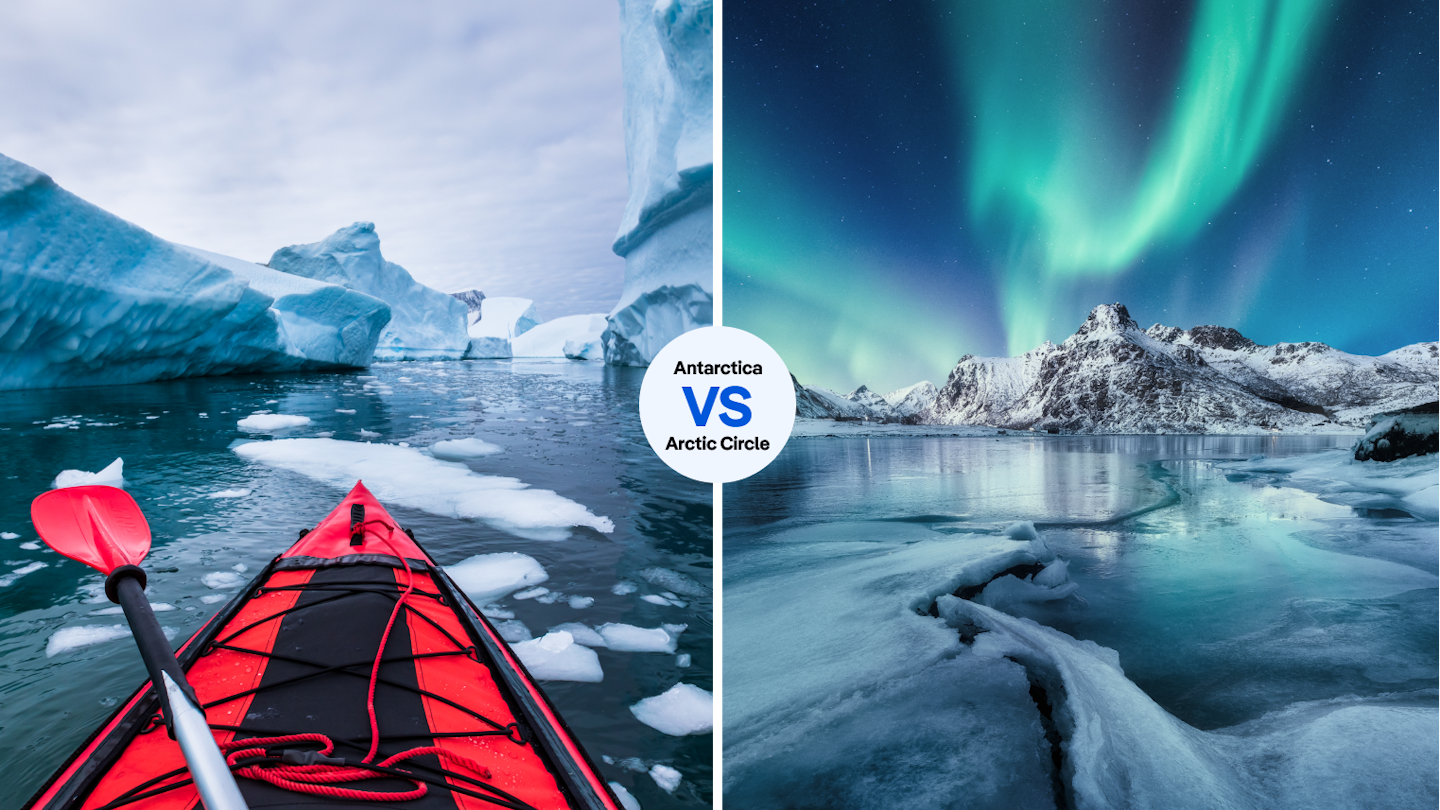Thinking of something a bit bigger than another beach holiday? We might suggest heading to the remotest points on Earth – literally.
On opposite poles of the globe, Antarctica and the Arctic have long appealed to the imaginations of explorers. Now that you’ve started dreaming big yourself, you have a decision to make: head way north or extremely south.
Read on for insights on which frigid wonderland might fulfill your extreme-travel fantasy.
Antarctica: Journey to the Ends of the Earth
A lover of polar extremes, Kerry Walker is never happier than in very cold places far removed from civilization.
There’s no feeling on Earth like arriving in Antarctica. After two days of rattling and rolling across the storm-tossed seas of the 600-mile-wide Drake Passage, reaching the White Continent is a moment of pure awe. Waves toss the ship from side to side as you traverse the planet’s roughest stretch of ocean – but then, overnight, the relentless swells and gunmetal-gray skies are gone. You wake up to a whole new world. The world in dazzling technicolor. The world as you’ve never seen it before.

On a March voyage to Antarctica, I remember peeking out of my cabin window in Fournier Bay that first morning and rubbing my eyes in disbelief. There were penguins porpoising through stained-glass-blue waters; seals lolling on icebergs, whales breaching and fluke-flashing; dark, rugged mountains leaping out of the sea, with glaciers spilling down their sides like giant crushed meringues. Some 30 humpback whales formed a welcome party, blowing and breaching breathtakingly close to the ship.
Here, shimmering white wonderland seems like a place a child might draw. A place that belongs in dreams, the final frontier of the imagination. No documentary prepares you for the reality of it: Antarctica is unlike anywhere you have ever been or are ever likely to go again. Here, wildlife rules and humans are merely passing through. Unlike in the Arctic, there is no development—no hotels or restaurants, no roads or railways, just nature running free.
Isn’t that a rare and precious thing?

Though I have visited the Arctic many times, I have been to Antarctica but once. Yet that first image burned deep into my memory: 15,000 gentoo penguins honking like party horns and sledding headfirst down icy slopes on Cuverville Island, sailing through the breathtaking Lemaire Channel—so beautiful it’s often called “Kodak Gap.”
There’s no doubt the Arctic is magical, with its snowy landscapes and adventures like dogsledding. However, it can never rival Antarctica for the surreal feeling of being dropped in a world you never realized existed. Wildlife is just everywhere in Antarctica, having a ball.

When you make the voyage to Antarctica on an icebreaker, it’s an effort and an investment. You need two days to get there by expedition ship from Argentina’s southernmost tip, Ushuaia. It’s physically demanding: the bone-chilling cold, the journey, and the risk of seasickness. It’s also expensive: a 10-night expedition in a shared cabin typically costs around £6000. Yet, trust me, it is worth every single penny. You’ll probably only go to Antarctica once, but it will stay with you forever.
And you’ll never look at the world the same way again.
The Arctic: A Shade of White with Many Colors
A contributor to over 70 travel guides, Luke Waterson thrives far from the nearest road or wi-fi connection.
The Arctic means vastly different things to different people. Any land north of the Arctic Circle can be labeled as “Arctic”; Norway, Sweden, Finland, a chunk of Russia, Alaska, Canada, and Greenland fall within this zone. Daily life in much of this area is similar to other places, albeit with more snow and ice to navigate.

Then there are extreme compass points: Alaska’s Kaktovik, Churchill, and Nunavut territory in Canada—the Svalbard archipelago is densely snowed under most of the year, roamed by polar bears and illuminated by northern lights for months. And there is the North Pole itself, reachable only by scientific expedition.
All this means the Arctic is much more than one vast expanse of chilly wilderness. It hosts a huge diversity of wildlife and a captivating human history spanning 40,000 years. When I think of the Arctic, I also think of its colors: the aurora borealis illuminating long nights in shimmering streaks of green and pink.

Both are thrilling, frigid no-man’s-lands. Both experience stunning aurora activity. In both regions, the natural landscape dwarfs human presence. However, the Arctic is much easier to access compared to Antarctica, which requires a minimum two-day sea crossing from Ushuaia, Argentina. The Arctic is within few hours’ flight—and incredibly affordable access from North America, Europe, and Asia.
In the end, the Arctic is rapidly changing. Some reports suggest that it could be ice-free by the 2040s. Iconic creatures like the polar bear may vanish from the wild by then. Thus, the need to understand climate change is greater in the Arctic than anywhere else, as it will be affected first. Looking at it fatalistically, see the Arctic now.
Before it’s too late.





